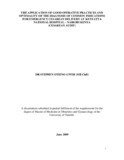| dc.contributor.author | Gwer, Stephen O | |
| dc.date.accessioned | 2013-05-24T07:51:34Z | |
| dc.date.available | 2013-05-24T07:51:34Z | |
| dc.date.issued | 2009 | |
| dc.identifier.citation | Master of Medicine in Obstetrics and Gynaecology | en |
| dc.identifier.uri | http://erepository.uonbi.ac.ke:8080/xmlui/handle/11295/25177 | |
| dc.description.abstract | This study evaluated the diagnosis of common indications for emergency cesarean
delivery at Kenyatta National Hospital (KNH). It focused on optimality of the diagnoses
and evaluated some of the practices at cesarean delivery that are associated with
favourable outcomes.
Design: Cross sectional descriptive study
Study site: The study was conducted at KNH Department of Obstetrics.
Methods: Case note for all deliveries in Kl"JHbetween 18th January and 23rd February
2009 both dates inclusive were sought and perused daily. Eligible consecutive pregnant
women, for whom a decision to undergo emergency cesarean delivery for the following
diagnoses; Prior uterine scar, presumed fetal c..ompromise, hypertensive disease in
pregnancy, breech presentation, dystocia and third trimester bleeding, were recruited to
the study. These had been determined to be the six leading indications for emergency CD
in the unit. A questionnaire was filled by obtaining details from their case notes, nursing
care notes and treatment sheets.
Optimality of diagnosis, Decision to Delivery Interval, Senior consultation, use of
prophylactic antibiotics and of regional anaesthesia was determined and described.
Data was analyzed using SPSS version 11, descriptive statistics are presented. Chi square
tests were used to determine significance.
Results: One thousand and eighty women were delivered during the study duration, 409
via cesarean (CSR-37.9%). 306 of327 eligible women were recruited. 51% had a sub
optimal diagnosis with Prior uterine scar and presumed fetal compromise being the main
contributors (72%). Most (88%) of the time there was no senior consultation. Only 10%
were delivered within an hour of decision. Most (97%)'were not given prophylactic
antibiotics and 57% were offered spinal anaesthesia. Maternal and fetal outcomes were
worse in those with an optimal diagnosis. The Still birth rate (SBR) was 12.5; Early
Perinatal Mortality Rate (EPMR) was 58.8, Neonatal Death Rate (NDR) of 12.2 per 1000
live births. One participant died during the study duration due to haemorrhage giving a
case fatality rate of 0.33%.
Conclusions: The CSR was high; with the common indications we sought contributing
68% of all the cesarean deliveries (Emergency and Elective cases) and 85% of the
emergency sections. Prior uterine scar and presumed fetal compromise were the largest
contributors to suboptimal diagnosis. Rarely were the consultants' opinions sought prior
to decision and few of the patients were delivered within an hour of decision. Pre
operative antibiotic prophylaxis was hardly (3%) ever prescribed, with over half of the
women being offered spinal anaesthesia. Maternal and fetal outcomes were worse
amongst those found to have an optimal diagnosis.
Recommendations: Strategies to increase optimal diagnosis for emergency cesarean
deliveries be formulated. Measures to: promote consultation prior to decision, shorten the
decision to delivery interval, ensure provision of preoperative antibiotic prophylaxis, and
promote the use of regional anaesthesia be instituted, for women undergoing emergency
cesarean section. A more comprehensive study should be done in the future to check the
trends and assess other parameters like the sepsis rate and other long term complications. | en |
| dc.description.sponsorship | University of Nairobi | en |
| dc.language.iso | en | en |
| dc.title | The application of good operative practices and optimality of the diagnosis of common indications for emergency cesarean delivery at Kenyatta National Hospital - Nairobi Kenya (cesarean audit) | en |
| dc.type | Thesis | en |
| dc.description.department | a
Department of Psychiatry, University of Nairobi, ; bDepartment of Mental Health, School of Medicine,
Moi University, Eldoret, Kenya | |
| local.publisher | Department of Medicine, College of Health Sciences, University of Nairobi, | en |

